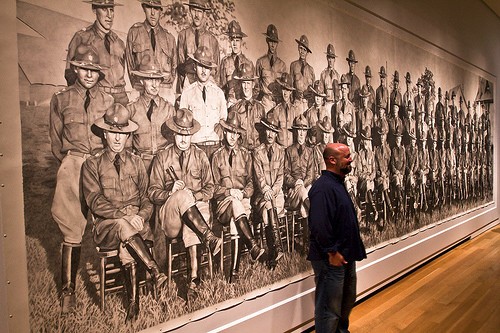Artist winner of $250,000 laments celebrity

Courtesy Photo / Google Images Chris LaPorte, winner of the 2010 Artprize, stand in front of his work
Nov 11, 2010
Grand Rapids artist Chris LaPorte describes himself as a “private person,” so the celebrity that comes with winning one of the country’s biggest art competitions has left him feeling “very uncomfortable.”
His colleagues describe him as “very humble,” but a $250,000 cash prize could challenge anyone’s sense of humility.
The day after the 36-year-old took first place in ArtPrize 2010, he was at Aquinas College running a drawing session, a commitment he made before being named a finalist in the annual art competition.
LaPorte’s winning submission, an 8-by-28 foot pencil drawing titled “Cavalry, American Officers, 1921,” has given the part-time Aquinas art professor more fame than he ever wanted.
“I think that my desire to be a visual artist is a desire to make this thing that takes the focus off of me and onto it,” LaPorte said. “The weird and intense irony is how making it has brought me all this attention. I suspect that some artists are drawn to that spotlight, but I’m not really.”
LaPorte’s late father, Larry, inspired work on “Cavalry, American Officers, 1921,” which took about 800 hours to complete. Larry died in September 2009 at age 71 after a vehicle struck the bicycle he rode.
LaPorte struggled with the unexpected loss of his father and channeled his emotions by recommitting himself to his artwork.
Shortly after his father’s death, he found an old photograph of his grandmother and her siblings and decided that he needed to draw it.
“I knew it needed to be life-size – it needed to be alive,” he said. “It was kind of weird. I just made this thing not really thinking about how this fits into the context of art history or my previous work or whatever. I just needed to make this thing.”
LaPorte used the 4-by-7 foot pencil drawing of his grandmother and her siblings, which he named “Navarre’s of Woodside,” as a prelude to “Cavalry” to see if he could complete a large-scale sketch in time for ArtPrize’s deadline. When he finished “Navarre’s of Woodside,” LaPorte turned his attention to another old photograph, one he found in an antique shop. The small, sepia-toned picture showed a U.S. military regiment circa World War I.
LaPorte said he made some connections to his father while he worked on the award-winning drawing, but not until later did he realize the significance of the piece.
“It wasn’t until toward the end when my girlfriend and I put all the pieces together that I realized the reason I had been bringing all these people, who were certainly gone, back to life – it was that I was trying to bring my old man back,” he said. “I was trying in some weird way to bring him back, but it’s not going to happen, so it feels like stabbing in the dark.”
LaPorte said his drawing, which contains the faces of 53 World War I-era cavalry officers, is a portrait of his father without actually depicting his father’s image.
“He was just this Dudley-Do-Right kind of guy, and all those guys are Dudley-Do-Right-ish,” he said. “There’s even one guy – the second guy in the front row from the left – he’s out, or it looks like he’s out. My dad was kind of a narcoleptic, and if he was in a crowded room he could just kind of fall asleep, and I couldn’t help but chuckle to myself and think that in this big group of people, in this seemingly important moment, this guy is out.”
Visitors waited in lines that snaked through the Grand Rapids Art Museum during the three-week event to see the emotion and attention to detail LaPorte conveys in his massive drawing.
Ron Pederson, co-chairman of the Aquinas art department, saw LaPorte’s drawing a week before ArtPrize began.
“The emotional impact it had on me hit me like a load of bricks, and I started weeping,” Pederson said. “Many others felt this, and I think it speaks to the spirituality of the artwork. It doesn’t have to do with religion – it just moves you.”























